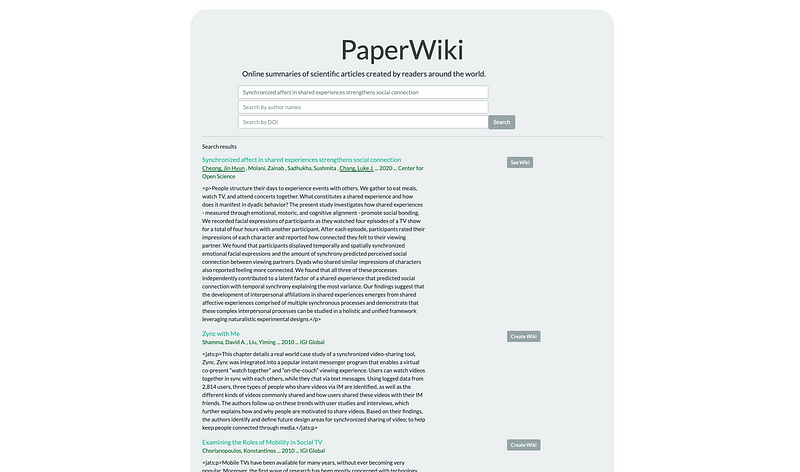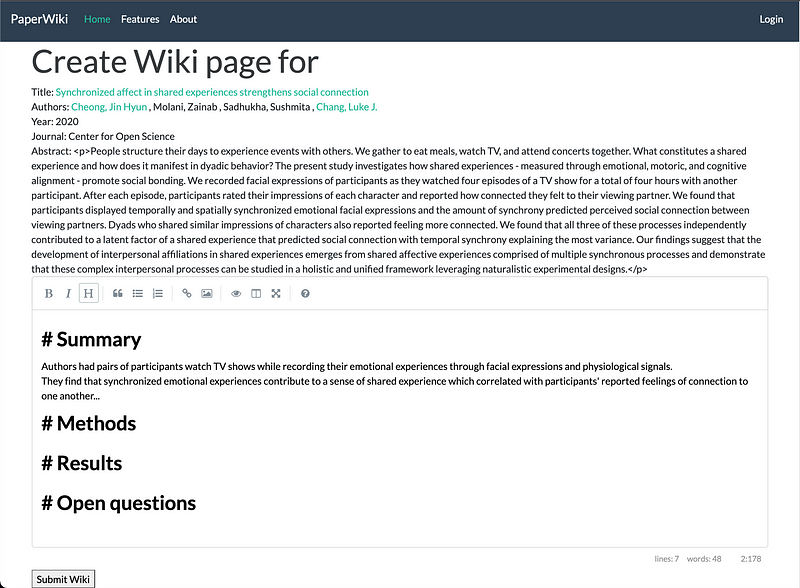Innovative Approach to Scientific Collaboration through PaperWiki
Written on
Understanding the Challenges in Scientific Research
In the summer of 2018, during my journey as an aspiring neuroscientist, I participated in a program at the University of Washington in Seattle. The initial week focused on coding and data analysis, while the subsequent week was dedicated to a hackathon where we aimed to develop tools to improve scientific research.
The Struggles of Engaging with Scientific Literature
As I contemplated ways to contribute to the scientific community, I reflected on my primary obstacles in research. One significant hurdle was reading scientific articles. While I don't dislike reading, navigating through dense and jargon-heavy journal articles can often feel isolating. These publications are typically packed with data and complex ideas, leaving little room for understanding others' perspectives. If you're fortunate, you might participate in a journal club, where only a fraction of attendees have read the material, or catch fleeting discussions on academic Twitter, quickly overshadowed by newer publications.
During high school, I found solace in resources like Wikipedia and SparkNotes when tasked with reading assignments. SparkNotes provided concise summaries that greatly aided my understanding, while Wikipedia showcased the effectiveness of crowdsourced knowledge, allowing people to collaboratively explain intricate theories in an accessible manner.
Inspired by these platforms, I envisioned a similar resource for academic papers: a space for individuals to share and co-create summaries of scientific articles.

Key Features of PaperWiki
PaperWiki was designed with two primary functionalities: 1) the ability to search for scientific articles, and 2) the capability to create or edit summaries linked to those articles.
Feature 1: Searching for Scientific Articles
Initially, I believed that implementing the search feature would be straightforward. I intended to utilize Google Scholar, renowned for its ability to pinpoint articles using minimal information. Unfortunately, I discovered that Google Scholar does not provide an API. My attempt to use a web wrapper was thwarted when I was blocked after just a few queries.
Ultimately, I resorted to Crossref API, a publicly accessible REST API. Although its search capabilities were not optimal, it came with a solid Python library compatible with the Flask framework I was using.

Feature 2: Creating and Editing Summaries
I aimed for the editing experience to be intuitive and user-friendly, including the option to save images for enhanced comprehension. After some exploration, I discovered Flask-PageDown, which allowed for Markdown editing within Flask. Users could easily click “Create Wiki” to generate a new summary or “See Wiki” to access an existing page for that article.

Future Directions for Enhancing Scientific Engagement
While PaperWiki is still in its early stages, I genuinely believe it has the potential to democratize access to scientific information. I plan to introduce additional features in the coming months, including 1) personalized article tracking lists for users to monitor their contributions and 2) shared reading lists for educators to compile articles with a collaborative blank page for student input.
Reflecting on the development of PaperWiki, I find it to be an exhilarating endeavor, and I am committed to its growth. I welcome anyone who shares my enthusiasm for open science to reach out or contribute to the project repository.
To learn more, visit Paperwiki.org.
The first video discusses the use of Wikipedia in academic research, highlighting potential dangers and offering tips for better research practices.
The second video showcases the Wikimedia Research Showcase from April 2019, providing insights into collaborative efforts in scientific research.